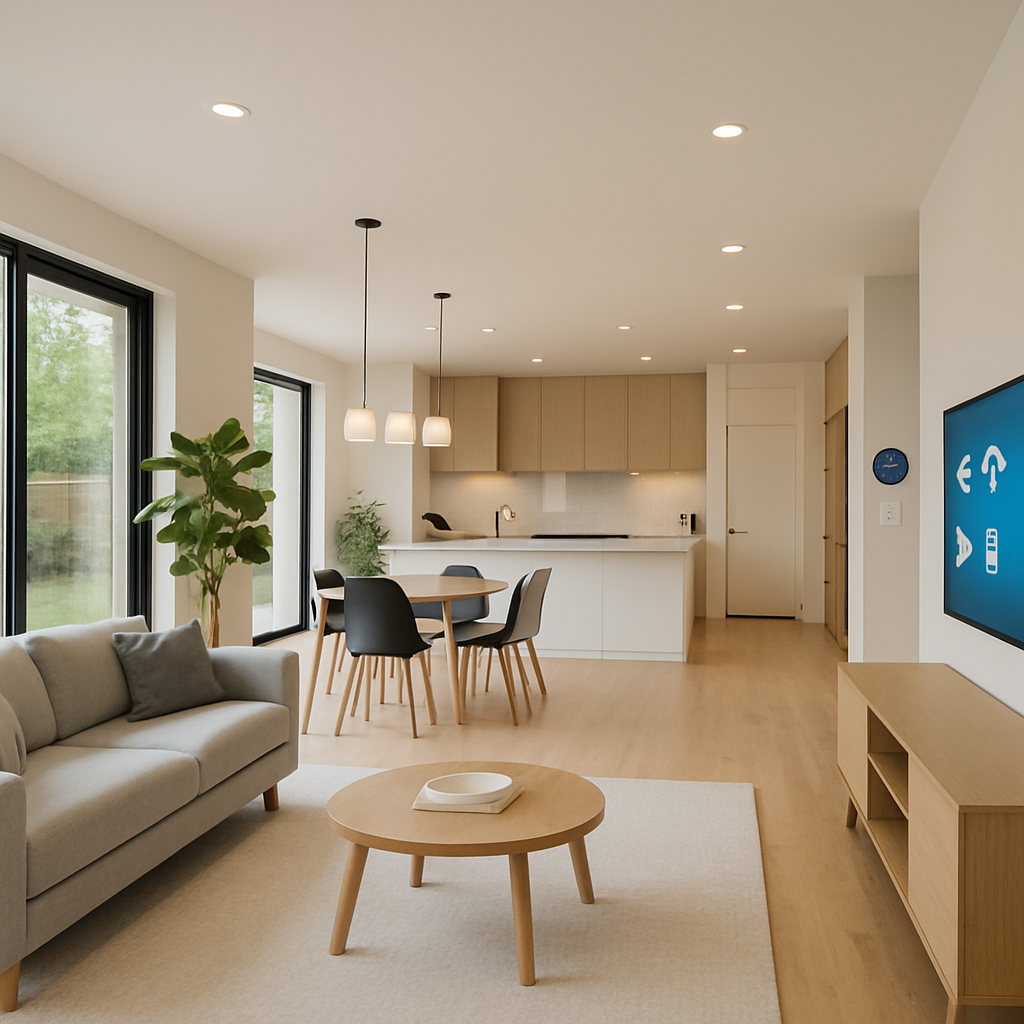Residential design trends for 2025 are shaping the future of home living. Homeowners are eager to embrace these exciting changes.
Smart home features are at the forefront, offering convenience and efficiency. These innovations are transforming how we interact with our living spaces.
Modern house plans are evolving, focusing on open concepts and flexible spaces. This approach maximizes light and space, creating a more inviting environment.
Sustainable home design is a priority, with eco-friendly materials and energy-efficient systems in high demand. Homeowners are keen to reduce their environmental impact.
Biophilic design, which incorporates natural elements, is gaining popularity. This trend brings the outdoors inside, promoting wellness and tranquility.
Personalization is key, as homeowners seek unique designs that reflect their style. The future of residential architecture is both innovative and inspiring.
The Rise of Smart Home Features in 2025
In 2025, smart home features are not just an option; they’re essential. Homeowners are integrating these technologies for enhanced convenience and efficiency. The demand for smart systems continues to rise as they become more affordable and accessible.
These features now span multiple areas of the home. From smart lighting and climate control to advanced security systems, technology is enhancing residential architecture at all levels. The ability to control these features remotely is a major draw.
Key smart home features include:
- Smart lighting systems that adjust based on time or occupancy
- Climate control systems that optimize energy use
- Advanced security systems with real-time monitoring
Additionally, smart kitchens have become a significant trend. They feature advanced appliances and connectivity that simplify cooking and meal planning. This makes everyday tasks more manageable and enjoyable for homeowners.
Moreover, the integration of smart home technology has paved the way for increased energy efficiency. This means reduced energy costs and a smaller carbon footprint. As technology evolves, these smart systems are becoming more intuitive, ensuring a seamless user experience. This rise in smart home features highlights their importance in modern house plans, making homes more efficient and responsive to residents’ needs.
Modern House Plans: Open Concepts and Flexible Spaces
Modern house plans for 2025 focus heavily on open concept designs. This trend emphasizes space and light, creating airy and welcoming environments. Open layouts are particularly popular in living areas and kitchens, where family and friends gather.
The appeal of open concepts lies in their versatility. They allow for seamless integration between living spaces. For example, kitchens blend into dining areas, forming a cohesive and functional space. This kind of integration enhances interaction and communication among occupants.
In addition to open layouts, flexibility is key. Homeowners are looking for adaptable spaces that cater to various needs. Rooms that can transform into offices, gyms, or guest rooms are highly valued. This adaptability is especially crucial as more people work from home.
Key elements of modern house plans include:
- Open kitchen and living room layouts
- Flexible spaces for multiple uses
- Utilization of natural light through large windows

These plans cater to diverse lifestyle needs while maintaining a cohesive design aesthetic. Emphasizing clean lines and uncluttered spaces, they reflect a minimalist approach. The focus on openness and flexibility aligns with broader home design trends, bringing comfort and functionality to the forefront. As a result, modern house plans continue to shape the evolving landscape of residential architecture.
Sustainable Home Design: Eco-Friendly and Energy-Efficient Living
Sustainable home design is more than just a trend in 2025; it’s a necessity. As environmental awareness grows, eco-friendly practices are at the forefront of residential architecture. Homeowners are increasingly interested in reducing their carbon footprints.
Energy-efficient systems play a crucial role in sustainable home design. Many new homes incorporate smart thermostats and LED lighting. These systems lower energy consumption and, in turn, reduce utility bills. Solar panels are also becoming a common feature, providing renewable energy.
Additionally, choosing sustainable materials is key. Builders are opting for recycled and locally sourced materials to minimize environmental impact. These choices contribute to the overall sustainability of a home while supporting eco-friendly practices.
Another focus is water conservation. Homeowners are installing water-saving fixtures. These include low-flow showers and faucets. Water-efficient landscaping is also gaining popularity, encouraging responsible water use.
Key elements of sustainable home design include:
- Energy-efficient systems like solar panels
- Use of recycled and sustainable materials
- Water-saving fixtures and efficient landscaping

Designs that incorporate these elements not only benefit the environment but also offer economic benefits. Sustainable homes often require less maintenance and provide long-term savings. As awareness continues to grow, eco-friendly home designs are becoming the standard for future residential projects, meeting both ecological and personal needs.
Biophilic and Wellness-Focused Home Design Ideas
In 2025, biophilic design is revolutionizing home spaces, bringing nature inside. This trend enhances our connection with the natural environment. Integrating greenery into homes encourages mental well-being.
Incorporating natural elements like plants and water features brings tranquility. Large windows and glass doors maximize daylight exposure, improving mood and productivity. This approach aligns with the wellness-focused design intent.
Colors and materials also reflect nature’s palette. Earthy tones and natural textures create soothing environments. Materials such as wood and stone add organic warmth to living spaces. These features work together to nurture relaxation and calmness.
Homeowners opt for design elements promoting overall wellness. Key features include:
- Indoor gardens or vertical greenery
- Natural lighting via large windows
- Calming color schemes with natural hues

Designing with wellness in mind extends beyond aesthetics. It creates spaces that promote health and happiness, making homes sanctuaries from daily stresses. As more people prioritize wellness, biophilic designs grow in appeal, shaping homes of tomorrow.
Popular Floor Plans: Multi-Functional and Adaptable Spaces
In 2025, adaptability is key in residential design. Homeowners demand versatile spaces that evolve with their needs. Multi-functional rooms are becoming a focal point in modern house plans.
Open floor plans offer fluidity and flexibility. They allow spaces to seamlessly transition from one function to another. For example, a living room can quickly become a home office or entertainment area. This adaptability is crucial as lifestyles change.
Designers are embracing this shift toward functional versatility. They incorporate features that enhance usability. For instance, movable partitions can create private areas without permanent changes. Furniture choices that cater to multiple uses are also gaining popularity.
Here are popular features of adaptable spaces:
- Movable walls and partitions
- Convertible furniture
- Open-concept layouts that allow space reconfiguration

Adaptable floor plans cater to diverse household needs. They address the necessity for dynamic living in evolving environments. As people’s lives change, so must their homes. This trend ensures that residences can accommodate shifting demands and preferences, offering lasting value and relevance.
Indoor-Outdoor Living: Blurring the Boundaries
Indoor-outdoor living has become a significant trend in residential design. Homeowners want to connect more with nature. This concept involves creating seamless transitions between indoor and outdoor spaces.
Large glass doors and windows are essential for this trend. They maximize natural light and bring the outdoors inside. Sliding or folding doors can open up a home, merging it with the garden or patio. This integration enhances both aesthetics and functionality.
Outdoor areas are designed as extensions of the indoor living space. Comfortable seating, outdoor kitchens, and fireplaces create welcoming environments. These spaces are perfect for relaxation, entertainment, and family gatherings.
Key features of indoor-outdoor living include:
- Large, operable glass doors and windows
- Weather-resistant furniture
- Landscaping that complements the indoor decor

Seamless indoor-outdoor living enhances the overall home experience. It offers a sense of freedom and expansiveness. By blurring the boundaries, these designs invite nature in and create a harmonious home environment.
Personalization and Unique Residential Architecture
Homeowners in 2025 are gravitating towards personalization in residential architecture. They want spaces that reflect individual tastes and lifestyles. This shift stems from a growing desire for homes that feel truly one’s own.
Custom-designed features are becoming a hallmark of unique architecture. People are selecting materials, colors, and layouts that resonate with their personalities. This trend is evident in choices like bespoke cabinetry, custom lighting fixtures, and tailored furniture pieces.
Beyond aesthetics, functionality drives personalization. Homeowners are asking for adaptable spaces that serve multiple purposes. For example, a room might function as both an office and a guest bedroom.
Key personalization trends include:
- Custom design elements, such as built-in storage solutions
- Use of bold colors and unique textures
- Incorporation of personal art and collections

Architects are embracing creativity and innovation to meet these demands. They are using advanced tools and techniques to craft bespoke spaces. This approach allows for a home that not only looks unique but also supports diverse lifestyles.
Technology and Innovation in Home Design Trends
The integration of technology in home design is more revolutionary than ever in 2025. Homes are becoming smarter and more intuitive, driven by the latest innovations. Technology is now a fundamental component of modern living spaces.
Home automation systems are commonplace, offering convenience and efficiency. They allow homeowners to control lighting, temperature, and security with ease. These systems not only enhance comfort but also improve energy efficiency.
Advanced smart home features are continually expanding. Homeowners are prioritizing innovations that bring substantial benefits. Key technology trends include:
- AI-powered climate control
- Smart security systems with real-time alerts
- Voice-activated home management systems

The trend goes beyond individual devices. There’s a growing emphasis on seamlessly integrating technology into the home’s design. This seamless blend ensures a future-ready home, enhancing both functionality and style.
Conclusion: Designing for the Future
As we look toward 2025, home design trends are shaping a dynamic future. The emphasis is on creating spaces that blend technology, sustainability, and personal style. Homeowners are drawn to innovative designs that reflect individual lifestyles and adapt to changing needs.
The future of residential architecture lies in the harmonious integration of smart features, sustainable practices, and flexible spaces. By focusing on these elements, we can build homes that are not only visually appealing but also efficient and resilient. Designing for the future involves embracing these trends to create living spaces that cater to well-being and functionality.






